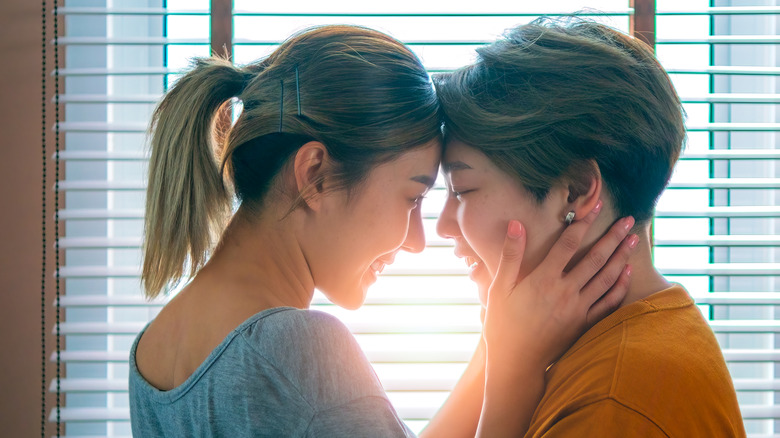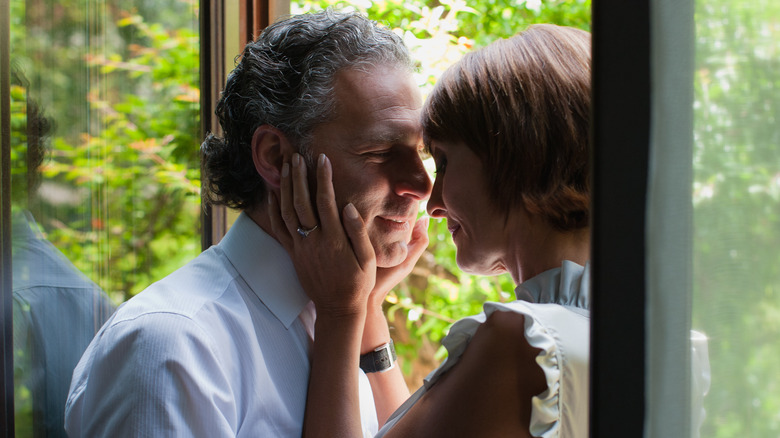What's A Secure Attachment Style And Why Is It So Ideal To Have?
In the 1950s, British psychiatrist and psychoanalyst John Bowlby developed the attachment theory. At the time, he was working with emotionally and mentally distressed children and how their behavior was related to their relationships with their caregivers. Through various observed studies, Bowlby and his team found that there were four attachment styles: secure, anxious, avoidant, and disorganized (fearful), according to The Attachment Project. Each attachment style stemmed from the relationship a child had with their parents or primary caregiver, and it would eventually follow them throughout their life.
"Attachment styles develop as a result of the bonds we make with our primary carers (usually our parents) when we are young babies," Relate counselor Holly Roberts tells Cosmopolitan. "Attachments are formed with our parents because they give us support, protection, and care, and we also learn how to manage our emotions based on how our parents interact with us."
While there isn't a "bad" attachment style, some are better than others especially when it comes to relating to people as we become adults. Our attachment styles have a big impact on how we communicate, express our emotions, handle conflict, and even how we love. Of the four, the secure attachment style is the only one that doesn't fall into the category of being insecure in nature. It's the ideal attachment style to have since it means that you were nurtured, protected, encouraged, and shown love in a positive way as a child. So what does that mean for the rest of a person's life with a secure attachment style?
More fulfilling relationships
When we're not shown as children how to positively relate to others, it can make for difficult relationships when we become adults. Let's be honest, relating to humans can be quite a task for anyone — but that's especially true if an individual has an insecure attachment style rather than a secure attachment style. In general, those with a secure attachment style are better at navigating relationships with everyone in their life — partners, family, friends, coworkers, and even acquaintances.
Meanwhile, those with avoidant, anxious, or disorganized attachments are more likely to distrust those they meet or fear having any type of relationship with them. Having a secure attachment — thanks to the nurturing affections of the primary caregiver toward this child — basically allows them to live their lives with an open heart and a greater acceptance of other people. And even with whatever differences those other people may bring to their life.
Those with a secure attachment style aren't just better at having relationships, but their relationships are also more fulfilling and more likely to be long-lasting. This is especially the case if both people in the relationship have secure attachment styles. That, right there, is what they call a win-win.
Great communicative skills
A 2011 study by Social and Behavioral Sciences published by Science Direct found that those with secure attachment styles excelled when it came to communication. Not only are they able to express their feelings, emotions, and disappointments in a calm manner, but when it comes to conflict resolution, they could handle relationship turbulence with ease. In the study, this was attributed to higher levels of problem-solving skills and self-confidence that those with a secure attachment style had developed in infancy, then carried with them into adulthood.
As we all know, communication is the very foundation of any healthy relationship — romantic, platonic, professional, or otherwise — but not everyone can communicate effectively to the same degree. So even if only one person in a relationship has a secure attachment style, it can make a big difference in how thoughts and emotions are conveyed, as well as how problems and arguments are resolved.
It makes it easier to manage emotions
According to research by the British Journal of General Practice, healthy attachment — which would be secure — allows babies to regulate their emotions and stress levels even before they're capable of self-regulating. It's the nurturing and consistent attention and love from their primary caregiver that, as infants, prepares them to better manage their emotions throughout their life and into adulthood. As stated by the study, "Stress regulation is important for exploration, learning, independence, and effective relationships."
None of which is to say that those with secure attachment styles will be immune to any issues. "Relationships for securely attached adults will still have ups and downs," Relate counselor Holly Roberts tells Cosmopolitan. "But you'll be more able to withstand any difficulties that might arise ... You'll be more able to regulate your emotions, meaning it's a bit easier to handle sadness and upset in a more balanced way."
Insecure attachments, on the other hand, being the other three styles, can create anxiety, emotional issues, behavioral problems, and in some cases even PTSD.
It can improve cognitive skills
When a child is the result of a family that supports their dreams, encourages them academically, and provides a safe space for them to be their authentic selves, it contributes to their cognitive development. As adults, these people think differently than those who have insecure attachment styles and they can explore and understand things on a deep level.
At work, this makes them good leaders, more dedicated to their job, and empathetic to those around them. They also report higher work satisfaction, as well as a lack of a fear of failure, according to The Attachment Project. In relationships, that means empathy, patience, understanding, and willingness to tackle any problem that might come their way in a positive and healthy manner.
Because the development of secure attachment plays such a role in one's cognitive ability, a 2019 study by Frontiers in Aging Neuroscience published in National Library of Medicine found that this could actually protect people from dementia as they get older. According to the study, "An early supportive social environment seems to have important implications for social, affective and cognitive abilities across the lifespan," thereby lowering chances of cognitive decline.
Secure attachment styles can build resillience
Of the four attachment styles, the one that's the most resilient is the secure group. You knock them down, they'll give themselves the opportunity to feel their feelings and express their emotions, and they then bounce back far faster than the other three styles. An example of this resilience is how those with a secure attachment style handle breakups.
"[They are] likely secure with themselves, which is very important with breakups," marriage and family therapist Jacob Kountz tells Bustle. "If one is secure with themselves enough during this experience, meaning they're confident and comfortable being single, there is less of a chance of someone who resonates with this style to have a debilitating reaction."
Of course, this isn't to suggest there won't be tears and a couple of pints of Ben & Jerry's on the horizon. But the ability to manage emotions and have a healthy view of the world is an asset in these types of situations.
A healthy amount of self-worth
When you're raised with a healthy amount of support and encouragement, it's only natural that you're going to have higher confidence than those who never received such things as babies and children. These are the people who end up being go-getters because they've been taught that they can make their dreams a reality.
"The child [with a secure attachment style] learns that their caregiver can be counted on," marriage and family therapist Sarah Epstein tells Forbes. "The safety they grow up with allows them to develop a healthy sense of self, feel lovable, and feel stable enough to really explore the world."
What's important to take away from this is that while the secure attachment style may be the ideal one, it doesn't mean that if your attachment style is one of insecurity, you're doomed. Through therapy, self-reflection, and observing others who have a secure attachment, you can actually change your attachment style. You just need to be prepared to put in the work to do it, because in some cases, it's going to mean a total overhaul of how you see and interact with the world.






